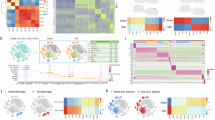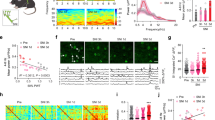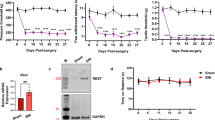Abstract
Peripheral nerve injury could lead to chronic neuropathic pain. Understanding transcriptional changes induced by nerve injury could provide fundamental insights into the complex pathogenesis of neuropathic pain. Gene expression profiles of dorsal root ganglia (DRG) in neuropathic pain condition have been studied. However, little is known about transcriptomic changes in individual DRG neurons after peripheral nerve injury. Here we performed single-cell RNA sequencing on dissociated mouse DRG cells after spared nerve injury (SNI). In addition to DRG neuron types that are found under physiological conditions, we identified three SNI-induced neuronal clusters (SNIICs) characterized by the expression of Atf3/Gfra3/Gal (SNIIC1), Atf3/Mrgprd (SNIIC2) and Atf3/S100b/Gal (SNIIC3). These SNIICs originated from Cldn9+/Gal+, Mrgprd+ and Trappc3l+ DRG neurons, respectively. Interestingly, SNIIC2 switched to SNIIC1 by increasing Gal and reducing Mrgprd expression 2 days after nerve injury. Inferring the gene regulatory networks after nerve injury, we revealed that activated transcription factors Atf3 and Egr1 in SNIICs could enhance Gal expression while activated Cpeb1 in SNIIC2 might suppress Mrgprd expression within 2 days after SNI. Furthermore, we mined the transcriptomic changes in the development of neuropathic pain to identify potential analgesic targets. We revealed that cardiotrophin-like cytokine factor 1, which activates astrocytes in the dorsal horn of spinal cord, was upregulated in SNIIC1 neurons and contributed to SNI-induced mechanical allodynia. Therefore, our results provide a new landscape to understand the dynamic course of neuron type changes and their underlying molecular mechanisms during the development of neuropathic pain.
Similar content being viewed by others
Log in or create a free account to read this content
Gain free access to this article, as well as selected content from this journal and more on nature.com
or
Data availability
Most datasets generated in the current study are available in the GSE155622. The other datasets analyzed in the current study are included in Li et al.14 Processed data also available in zhanglab.shbrainproject.com: 100. R scripts are available from the corresponding author upon reasonable request.
Change history
19 May 2021
A Correction to this paper has been published: https://doi.org/10.1038/s41422-021-00503-y
References
Colloca, L. et al. Neuropathic pain. Nat. Rev. Dis. Primers 3, 17002 (2017).
Costigan, M., Scholz, J. & Woolf, C. J. Neuropathic pain: a maladaptive response of the nervous system to damage. Annu. Rev. Neurosci. 32, 1–32 (2009).
Moreau, N. et al. Early alterations of Hedgehog signaling pathway in vascular endothelial cells after peripheral nerve injury elicit blood-nerve barrier disruption, nerve inflammation, and neuropathic pain development. Pain 157, 827–839 (2016).
Xiao, H. S. et al. Identification of gene expression profile of dorsal root ganglion in the rat peripheral axotomy model of neuropathic pain. Proc. Natl Acad. Sci. USA 99, 8360–8365 (2002).
Chandran, V. et al. A systems-level analysis of the peripheral nerve intrinsic axonal growth program. Neuron 89, 956–970 (2016).
Palmisano, I. et al. Epigenomic signatures underpin the axonal regenerative ability of dorsal root ganglia sensory neurons. Nat. Neurosci. 22, 1913–1924 (2019).
Ma, C. H. et al. Accelerating axonal growth promotes motor recovery after peripheral nerve injury in mice. J. Clin. Invest. 121, 4332–4347 (2011).
Chen, J. et al. The alpha2delta-1-NMDA receptor complex is critically involved in neuropathic pain development and gabapentin therapeutic actions. Cell Rep. 22, 2307–2321 (2018).
Ji, R. R., Chamessian, A. & Zhang, Y. Q. Pain regulation by non-neuronal cells and inflammation. Science 354, 572–577 (2016).
Ohara, P. T. et al. Gliopathic pain: when satellite glial cells go bad. Neuroscientist 15, 450–463 (2009).
Kim, Y. S. et al. Coupled activation of primary sensory. Neurons contributes to chronic pain. Neuron 91, 1085–1096 (2016).
Calvo, M. et al. The genetics of neuropathic pain from model organisms to clinical application. Neuron 104, 637–653 (2019).
Ziegenhain, C. et al. Comparative analysis of single-cell RNA sequencing methods. Mol. Cell 65, 631–643 (2017).
Li, C. L. et al. Somatosensory neuron types identified by high-coverage single-cell RNA-sequencing and functional heterogeneity. Cell Res. 26, 83–102 (2016).
Usoskin, D. et al. Unbiased classification of sensory neuron types by large-scale single-cell RNA sequencing. Nat. Neurosci. 18, 145–153 (2015).
Aibar, S. et al. SCENIC: single-cell regulatory network inference and clustering. Nat. Methods 14, 1083–1086 (2017).
Satija, R., Farrell, J. A., Gennert, D., Schier, A. F. & Regev, A. Spatial reconstruction of single-cell gene expression data. Nat. Biotechnol. 33, 495–502 (2015).
Trapnell, C. et al. The dynamics and regulators of cell fate decisions are revealed by pseudotemporal ordering of single cells. Nat. Biotechnol. 32, 381–386 (2014).
Qiu, X. et al. Single-cell mRNA quantification and differential analysis with Census. Nat. Methods 14, 309–315 (2017).
Stuart, T. et al. Comprehensive integration of single-cell data. Cell 177, 1888–1902 (2019).
Decosterd, I. & Woolf, C. J. Spared nerve injury: an animal model of persistent peripheral neuropathic pain. Pain 87, 149–158 (2000).
Butler, A., Hoffman, P., Smibert, P., Papalexi, E. & Satija, R. Integrating single-cell transcriptomic data across different conditions, technologies, and species. Nat. Biotechnol. 36, 411–420 (2018).
Picelli, S. et al. Full-length RNA-seq from single cells using Smart-seq2. Nat. Protoc. 9, 171–181 (2014).
Shi, T. J. et al. Somatostatin and its 2A receptor in dorsal root ganglia and dorsal horn of mouse and human: expression, trafficking and possible role in pain. Mol. Pain 10, 12 (2014).
Bautista, D. M. et al. The menthol receptor TRPM8 is the principal detector of environmental cold. Nature 448, 204–208 (2007).
Gundlach, A. L. et al. Relaxin family peptides and receptors in mammalian brain. Ann. N.Y. Acad. Sci. 1160, 226–235 (2009).
Tsujino, H. et al. Activating transcription factor 3 (ATF3) induction by axotomy in sensory and motoneurons: a novel neuronal marker of nerve injury. Mol. Cell Neurosci. 15, 170–182 (2000).
Renthal, W. et al. Transcriptional reprogramming of distinct peripheral sensory neuron subtypes after axonal injury. Neuron 108, 128–144 (2020).
Lang, R. et al. Physiology, signaling, and pharmacology of galanin peptides and receptors: three decades of emerging diversity. Pharmacol. Rev. 67, 118–175 (2015).
Qiu, X. et al. Reversed graph embedding resolves complex single-cell trajectories. Nat. Methods 14, 979–982 (2017).
Caterina, M. J. et al. The capsaicin receptor: a heat-activated ion channel in the pain pathway. Nature 389, 816–824 (1997).
Dib-Hajj, S. D., Yang, Y., Black, J. A. & Waxman, S. G. The Na(V)1.7 sodium channel: from molecule to man. Nat. Rev. Neurosci. 14, 49–62 (2013).
Delfini, M. C. et al. TAFA4, a chemokine-like protein, modulates injury-induced mechanical and chemical pain hypersensitivity in mice. Cell Rep. 5, 378–388 (2013).
Guan, Z. et al. Injured sensory neuron-derived CSF1 induces microglial proliferation and DAP12-dependent pain. Nat. Neurosci. 19, 94–101 (2016).
Coudore-Civiale, M. A., Courteix, C., Fialip, J., Boucher, M. & Eschalier, A. Spinal effect of the cholecystokinin-B receptor antagonist CI-988 on hyperalgesia, allodynia and morphine-induced analgesia in diabetic and mononeuropathic rats. Pain 88, 15–22 (2000).
Tsuzuki, K. et al. Differential regulation of P2X(3) mRNA expression by peripheral nerve injury in intact and injured neurons in the rat sensory ganglia. Pain 91, 351–360 (2001).
Barclay, J. et al. Functional downregulation of P2X3 receptor subunit in rat sensory neurons reveals a significant role in chronic neuropathic and inflammatory pain. J. Neurosci. 22, 8139–8147 (2002).
Li, J. et al. Nerve injury-induced neuronal PAP-I maintains neuropathic pain by activating spinal microglia. J. Neurosci. 40, 297–310 (2020).
Talbot, S., Foster, S. L. & Woolf, C. J. Neuroimmunity: physiology and pathology. Annu. Rev. Immunol. 34, 421–447 (2016).
Rose-John, S. Interleukin-6 Family Cytokines. Cold Spring Harb Perspect Biol. 10, a028415 (2018).
Taga, T. & Kishimoto, T. GP130 and the Interleukin-6 family of cytokines. Annu Rev. Immunol. 15, 797–819 (1997).
Elson, G. C. et al. CLF associates with CLC to form a functional heteromeric ligand for the CNTF receptor complex. Nat. Neurosci. 3, 867–872 (2000).
Forger, N. G. et al. Cardiotrophin-like cytokine/cytokine-like factor 1 is an essential trophic factor for lumbar and facial motoneurons in vivo. J. Neurosci. 23, 8854–8858 (2003).
Dallner, C., Woods, A. G., Deller, T., Kirsch, M. & Hofmann, H. D. C. N. T. F. and CNTF receptor alpha are constitutively expressed by astrocytes in the mouse brain. Glia 37, 374–378 (2002).
Zeisel, A. et al. Molecular architecture of the mouse nervous system. Cell 174, 999–1014 (2018).
Sharma, N. et al. The emergence of transcriptional identity in somatosensory neurons. Nature 577, 392–398 (2020).
Zeng, H. & Sanes, J. R. Neuronal cell-type classification: challenges, opportunities and the path forward. Nat. Rev. Neurosci. 18, 530–546 (2017).
Maxwell, D. J. & Rethelyi, M. Ultrastructure and synaptic connections of cutaneous afferent fibres in the spinal cord. Trends Neurosci. 18, 117–123 (1987).
Basbaum, A. I., Bautista, D. M., Scherrer, G. & Julius, D. Cellular and molecular mechanisms of pain. Cell 139, 267–284 (2009).
Costigan, M. et al. Replicate high-density rat genome oligonucleotide microarrays reveal hundreds of regulated genes in the dorsal root ganglion after peripheral nerve injury. BMC Neurosci. 3, 16 (2002).
Hokfelt, T., Johansson, O., Ljungdahl, A., Lundberg, J. M. & Schultzberg, M. Peptidergic neurones. Nature 284, 515–521 (1980).
Nguyen, M. Q., Le Pichon, C. E. & Ryba, N. Stereotyped transcriptomic transformation of somatosensory neurons in response to injury. Elife 8, e49679 (2019).
Ulasov, A. V., Rosenkranz, A. A. & Sobolev, A. S. Transcription factors: time to deliver. J. Control Release 269, 24–35 (2018).
Lambert, S. A. et al. The human transcription factors. Cell 172, 650–665 (2018).
Bennett, D. L., Clark, A. J., Huang, J., Waxman, S. G. & Dib-Hajj, S. D. The role of voltage-gated sodium channels in pain signaling. Physiol. Rev. 99, 1079–1151 (2019).
Faber, C. G. et al. Gain of function Nav1.7 mutations in idiopathic small fiber neuropathy. Ann. Neurol. 71, 26–39 (2012).
Faber, C. G. et al. Gain-of-function Nav1.8 mutations in painful neuropathy. Proc. Natl. Acad. Sci. USA 109, 19444–19449 (2012).
Huang, J. et al. Gain-of-function mutations in sodium channel Na(v)1.9 in painful neuropathy. Brain 137, 1627–1642 (2014).
Busserolles, J., Tsantoulas, C., Eschalier, A. & Lopez Garcia J. A. Potassium channels in neuropathic pain: advances, challenges, and emerging ideas. Pain 157 Suppl 1, S7–14 (2016).
Tsantoulas, C. et al. Kv2 dysfunction after peripheral axotomy enhances sensory neuron responsiveness to sustained input. Exp. Neurol. 251, 115–126 (2014).
Barclay, J. et al. Functional downregulation of P2X3receptor subunit in rat sensory neurons reveals a significant role in chronic neuropathic and inflammatory pain. J. Neurosci. 22, 8139–8147 (2002).
Zhang, X. et al. Down-regulation of μ-opioid receptors in rat and monkey dorsal root ganglion neurons and spinal cord after peripheral axotomy. Neuroscience 82, 223–240 (1997).
Tsuda, M., Beggs, S., Salter, M. W. & Inoue, K. Microglia and intractable chronic pain. Glia 61, 55–61 (2013).
Treutlein, E. M. et al. The prostaglandin E2 receptor EP3 controls CC-chemokine ligand 2-mediated neuropathic pain induced by mechanical nerve damage. J. Biol. Chem. 293, 9685–9695 (2018).
Okubo, M. et al. Macrophage-colony stimulating factor derived from injured primary afferent induces proliferation of spinal microglia and neuropathic pain in rats. PLoS ONE 11, e0153375 (2016).
Kettenmann, H., Hanisch, U. K., Noda, M. & Verkhratsky, A. Physiology of microglia. Physiol. Rev. 91, 461–553 (2011).
Abbadie, C. Chemokines, chemokine receptors and pain. Trends Immunol. 26, 529–534 (2005).
Luo, H. et al. Interleukin-17 regulates neuron-glial communications, synaptic transmission, and neuropathic pain after chemotherapy. Cell Rep. 29, 2384–2397 (2019).
Wang, Y. et al. IL-34 is a tissue-restricted ligand of CSF1R required for the development of Langerhans cells and microglia. Nat. Immunol. 13, 753–760 (2012).
Olson, W. et al. Sparse genetic tracing reveals regionally specific functional organization of mammalian nociceptors. Elife 6, e29507 (2017).
Taniguchi, H. et al. A resource of Cre driver lines for genetic targeting of GABAergic neurons in cerebral cortex. Neuron 71, 995–1013 (2011).
Wu, Z., Autry, A. E., Bergan, J. F., Watabe-Uchida, M. & Dulac, C. G. Galanin neurons in the medial preoptic area govern parental behaviour. Nature 509, 325–330 (2014).
Wu, Y. E., Pan, L., Zuo, Y., Li, X. & Hong, W. Detecting activated cell populations using single-cell RNA-seq. Neuron 96, 313–329 (2017).
Lun, A. T. L. et al. EmptyDrops: distinguishing cells from empty droplets in droplet-based single-cell RNA sequencing data. Genome Biol. 20, 63 (2019).
Griffiths, J. A., Richard, A. C., Bach, K., Lun, A. T. L. & Marioni, J. C. Detection and removal of barcode swapping in single-cell RNA-seq data. Nat. Commun. 9, 2667 (2018).
McCarthy, D. J., Campbell, K. R., Lun, A. T. & Wills, Q. F. Scater: pre-processing, quality control, normalization and visualization of single-cell RNA-seq data in R. Bioinformatics 33, 1179–1186 (2017).
Chen, S., Zhou, Y., Chen, Y. & Gu, J. fastp: an ultra-fast all-in-one FASTQ preprocessor. Bioinformatics 34, i884–i890 (2018).
Pertea, M., Kim, D., Pertea, G. M., Leek, J. T. & Salzberg, S. L. Transcript-level expression analysis of RNA-seq experiments with HISAT, StringTie and Ballgown. Nat. Protoc. 11, 1650–1667 (2016).
Kim, D., Langmead, B. & Salzberg, S. L. HISAT: a fast spliced aligner with low memory requirements. Nat. Methods 12, 357–360 (2015).
Wang, L., Wang, S. & Li, W. RSeQC: quality control of RNA-seq experiments. Bioinformatics 28, 2184–2185 (2012).
Zhou, Y. et al. Metascape provides a biologist-oriented resource for the analysis of systems-level datasets. Nat. Commun. 10, 1523 (2019).
Van de Sande, B. et al. A scalable SCENIC workflow for single-cell gene regulatory network analysis. Nat. Protoc. 15, 2247–2276 (2020).
Shannon, P. et al. Cytoscape: a software environment for integrated models of biomolecular interaction networks. Genome Res. 13, 2498–2504 (2003).
Yang, L. et al. FGF13 selectively regulates heat nociception by interacting with Nav1.7. Neuron 93, 806–821 (2017).
Acknowledgements
We thank Dr. Ping Hu for the comments and suggestions on the experimental design for the transcriptional regulation section. This work was supported by National Natural Science Foundation of China (31671094, 31630033, and 31600853), Chinese Academy of Sciences (QYZDYSSW-SMC007), the Strategic Priority Research Program of the Chinese Academy of Sciences (XDB39050100), the International Partnership Program of Chinese Academy of Sciences (172644KYS820170004), Science and Technology Commission of Shanghai Municipality (18JC1420301) and Innovation Fund for Medical Sciences of Chinese Academy of Medical Sciences (2019-I2M-5-082).
Author information
Authors and Affiliations
Contributions
X.Z., C.L., L.B., and L.W. conceived and designed the project. S.W. and D.W. performed 10× scRNA-seq. Y.C. performed single-cell experiments by Smart-seq2. K.W. and C.L. analyzed scRNA-seq data. S.W., K.W., and Y.L. performed histological experiments. S.W. performed behavioral experiments. K.W., C.L., and X.Z. wrote the manuscript.
Corresponding authors
Ethics declarations
Competing interests
The authors declare no competing interests.
Supplementary information
Rights and permissions
About this article
Cite this article
Wang, K., Wang, S., Chen, Y. et al. Single-cell transcriptomic analysis of somatosensory neurons uncovers temporal development of neuropathic pain. Cell Res 31, 904–918 (2021). https://doi.org/10.1038/s41422-021-00479-9
Received:
Accepted:
Published:
Issue date:
DOI: https://doi.org/10.1038/s41422-021-00479-9
This article is cited by
-
Targeting skeletal interoception: a novel mechanistic insight into intervertebral disc degeneration and pain management
Journal of Orthopaedic Surgery and Research (2025)
-
Unveiling the mechanisms of yanhusuo’s therapeutic effects in neuropathic pain through network pharmacology, single-cell RNA sequencing, and molecular docking
Hereditas (2025)
-
Single-cell sequencing systematically analyzed the mechanism of Emdogain on the restoration of delayed replantation periodontal membrane
International Journal of Oral Science (2025)
-
How microglia contribute to the induction and maintenance of neuropathic pain
Nature Reviews Neuroscience (2025)
-
Aging and injury drive neuronal senescence in the dorsal root ganglia
Nature Neuroscience (2025)



